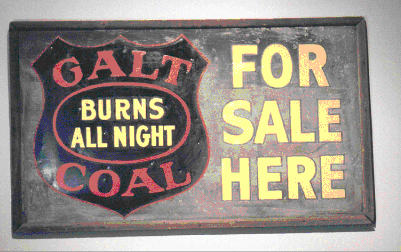
On one of his several inspection trips, Assistant Indian Commissioner Elliot T. Galt was using Sheran's ferry service when he saw the seam of coal on the riverbank in the Coal Banks area. He returned to the East, taking several samples of the coal with him to be analyzed. The coal was found to be of superior quality, but it had little value because there was no economical means of transporting it to a sizable market.

P19720061000-GM Elliot T. Galt with one of his sisters and a cousin, picture taken outside of his home.
The opportunity to mine coal came in 1881 when the Canadian Pacific Railway began to cross the southern prairies. This provided Galt with an effective method of transporting the coal to profitable markets. Recognizing this, Elliot obtained the help of his father, Sir Alexander Galt, a prominent Montreal promoter and the High Commissioner to London. The Galts analyzed the geological survey notes of Dr. Dawson and hired the services of Captain Nicholas Bryant, a mining engineer. Bryant was sent to the Prairies with William Stafford, a coal mining superintendent from Nova Scotia. Together they investigated the commercial mining possibilities of coal deposits in several areas of southern Alberta. After narrowing the possibilities and discussing the matter with the Galts, Bryant and Stafford chose the Coal Banks area as the best location for mining operations because of the superior quality of its coal.

P19750120000-GA, A familiar sign on the prairies. Galt coal was used in a variety of ways all across western Canada.
By 1882, Sir Alexander T. Galt was able to gather a small but powerful group of investors to form the North Western Coal and Navigation Company (NWC&NCo.). The Galts then established a coal mining enterprise that would continue to operate in southern Alberta for 30 years until they sold their remaining interests to the CPR in 1912.
Previous Page | Exhibit Contents | Home | Navigation Information | Glossary | Curriculum Guide | Next Page
Copyright © 1996 Sir Alexander Galt Museum. All rights reserved.